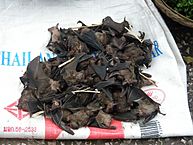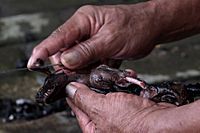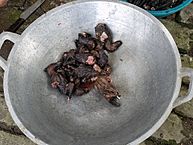Bat as food facts for kids

Bats are amazing flying mammals, and in some parts of the world, people eat them as food. This happens in countries across Asia, Africa, and the Pacific Ocean, like China, Vietnam, the Philippines, and Indonesia. People mostly hunt larger bats, known as fruit bats (or megabats), for food. About half of all fruit bat species are hunted, but only a small number of insect-eating bat species are. For example, in Guam, a type of fruit bat called the Mariana fruit bat is seen as a special food.
Contents
History of Eating Bats
People have probably been eating bats for a very long time, even before recorded history, especially in Asia and the Pacific. Scientists have found clues in old archaeological sites that suggest early humans might have eaten bats as far back as 74,000 years ago. On tropical islands, hunting large fruit bats was a good way to get food. These bats often live in caves in big groups, making them easier to catch.
Ancient Practices in Australia
Indigenous Australians have hunted bats for thousands of years, and some still do today. Popular types of bats they hunt include the black flying fox and the little red flying fox. In 1997, it was estimated that Aboriginal people in the Top End of Australia ate about 180,000 flying foxes each year.
Bats in European History
Eating bats in Europe has been rare. This is partly because people didn't like the idea, and also because European bats are usually small insect-eaters. However, in the past, some farmers in Italy were known to eat bats, especially horseshoe bats. After World War II, bats in some Italian caves almost disappeared because people hunted them so much.
Religious Views on Eating Bats
In some religious texts, like the Torah and the Bible, eating bats is forbidden. The book of Leviticus (11:13–19) says that bats are "an abomination" and should not be eaten.
Historical Accounts of Bat Consumption
The ancient Greek writer Strabo wrote about a city called Borsippa (in modern Iraq) where many bats were caught. The people there would "salad them to eat them." In the 1500s, an Italian scientist named Ulisse Aldrovandi wrote that bats have white, edible meat with an excellent flavor.
Where Bats Are Eaten Today
Around the world, at least 167 different types of bats are hunted. People hunt them for food, for traditional medicine, for their hides or teeth, or for sport. As mentioned, larger fruit bats are hunted much more often for food than smaller, insect-eating bats. A study from 2016 showed that bats are hunted for food or medicine in parts of Africa, Asia, and Oceania. However, they are generally not hunted for these reasons in Europe or North America.
Bat Consumption in Africa
In Africa, at least 55 species of bats are hunted, mostly in West and Central Africa. People prefer larger bats, while small insect-eating bats are not as popular. It's thought that about 100,000 bats are sold each year in Ghana. In other parts of Africa, like Southern and East Africa, there is very little bat hunting. The bats hunted in North Africa are mainly used for traditional medicine, not for food.
Some of the larger bats commonly eaten in Africa include the straw-coloured fruit bat and the hammer-headed bat. Medium-sized bats like the Angolan rousette are also eaten.
Bat Consumption in Asia
In Asia, people hunt 64 different bat species. The amount of hunting varies by region. In Southeast Asia, bats are widely hunted in almost all countries except Singapore. About 17% of all bat species in Southeast Asia are hunted.
The Philippines
The Philippines has a very high level of bat hunting. Even though there are laws to protect bats, they are often not enforced well. In places like Mayantoc in Tarlac province, eating fruit bats is very common. Locals go bat hunting and can catch dozens of bats in one trip. These bats are then prepared and cooked, often in a stew.
Malaysia and Thailand
In some cities in Malaysia, bats are seen as a luxury food. In Thailand, a survey in 2001 found that 7% of households in one wildlife sanctuary ate bat meat.
Indonesia
Consumption is especially high in North Sulawesi, Indonesia. Locals there eat flying fox meat at least once a month. This increases even more around Christian holidays.
South Asia
In South Asia, tribal groups in Bangladesh hunt bats for food, especially larger species. A survey in 2017 found that bats were hunted in almost half of the villages in Bangladesh. Most hunters used bats for both food and medicine. While bats are killed in India and Pakistan, eating them is less common. People there often use bats for perceived medicinal purposes instead. However, some studies suggest that eating bat meat is more common in certain parts of India, like the Northeast and the Andaman and Nicobar Islands.
East Asia and China
In East Asia, especially southern China, bats are sometimes eaten and can be found in some markets. Specific bat species eaten in China include the cave nectar bat and the Indian flying fox. However, eating bat meat is not very popular in China. According to a nutrition expert from the University of Beijing, "eating bat meat is more than rare in China. It is actually unacceptable in Chinese culture."
There was some confusion during the COVID-19 outbreak about whether the Huanan Seafood Wholesale Market in Wuhan sold bat meat. It was later confirmed that a video showing a woman eating a bat, which some media outlets claimed was from Wuhan, was actually filmed in Palau in 2016. Following the SARS outbreak in the early 2000s, there were calls for China to ban bat hunting and sale. In January 2020, in response to the coronavirus pandemic, all wildlife trade in China, including bat meat, was banned.
Bat Consumption in Oceania
Bats are regularly hunted and eaten in Oceania. On many isolated islands, bats are the only native land mammals. About 23% of Oceania's bat species are hunted. Bat meat is considered a special food in places like the Cook Islands, Niue, Guam, and Samoa. It is also commonly eaten in Fiji, New Caledonia, and Vanuatu.
Bat Consumption in South America
Even though South America has many different kinds of bats, they are rarely eaten there. Some indigenous groups, like the Nambiquara people, are known to eat a few species of leaf-nosed bat. Live bats are sold in Bolivia for traditional medicine. People believe that drinking bat blood can help treat epilepsy. A 2010 study found that 3,000 bats were sold each month in markets in four Bolivian cities.
How Bats Are Prepared and Cooked

Bats are prepared in many different ways around the world.
Bat Adobo in the Philippines
In the Philippines, especially in Mayantoc, Tarlac, locals make a dish called Bat adobo. After catching and killing the bats, they are skinned, beheaded, and their wings are removed. Then, they are cleaned, chopped up, and stewed. Guava is sometimes used to make the meat tender. The meat is then seasoned and cooked with onions, garlic, and soy sauce, much like regular Philippine adobo.
Paniki in Indonesia
Paniki is a traditional dish from the Minahasan people in North Sulawesi, Indonesia. It is made from fruit bats. Bat meat is also used in Soups, stews, and curries.
Bat Soup in Palau
In Palau, bat soup is considered a special food. Fruit bats are used to make this soup, which also includes coconut milk, spices, and ginger.
Other Cooking Methods
In some restaurants in southern China, you can find Hot pot made with whole bats. Bat stew is also a common dish. Estufa de morcego is a special bat stew from São Tomé and Príncipe that is served on holidays.
Many people say that fruit bats taste similar to chicken. They are often described as "clean animals living exclusively on fruit." Bats can be prepared in several ways, such as grilled, barbecued, deep fried, or cooked in stews and stir frys. When deep fried, the whole bat might be cooked and eaten.
- Bat preparation
-
Bats for human consumption in Laos
Nutrition from Bat Meat
Detailed information about the nutrients in bat meat is not widely available. However, in many developing countries, bushmeat (which includes bat meat) is an important source of food and nutrients. For example, a study in Madagascar suggested that if people couldn't access bushmeat, childhood anemia (a condition caused by lack of iron) could increase by 29%. This would mostly affect the poorest families who cannot afford other types of meat.
Challenges Related to Bat Consumption
Eating bats can lead to certain problems, including overhunting and the spread of diseases.
Overhunting Bats
Bats are very sensitive to overhunting, especially in Indonesia, the Philippines, Malaysia, and islands in Oceania. This is because bats naturally have low reproduction rates. Also, many species live in large groups, which makes it easier for hunters to catch many bats at once. Overhunting is believed to be the main reason why the small Mauritian flying fox and the Guam flying fox became extinct.
Diseases from Bats
Scientists have looked into whether fruit bats might carry viruses like Ebolavirus. While the evidence is not completely clear, some countries in West Africa banned bushmeat (including bats) during the 2013–2016 Ebola epidemic. Many of these bans have since been lifted.
Bats have also been suggested as a possible source of the SARS-CoV-2 virus, which caused the coronavirus pandemic and was first found in Wuhan, China. However, the exact origin of the virus is still being studied.
Toxins in Bat Meat
Eating fruit bats has also been linked to a brain disease called lytico-bodig disease. Researchers have found that bats eat large amounts of cycad seeds. These seeds contain toxins, and the bats seem to store these toxins in their meat at dangerous levels.
See also
 In Spanish: Alimento a base de murciélago para niños
In Spanish: Alimento a base de murciélago para niños






